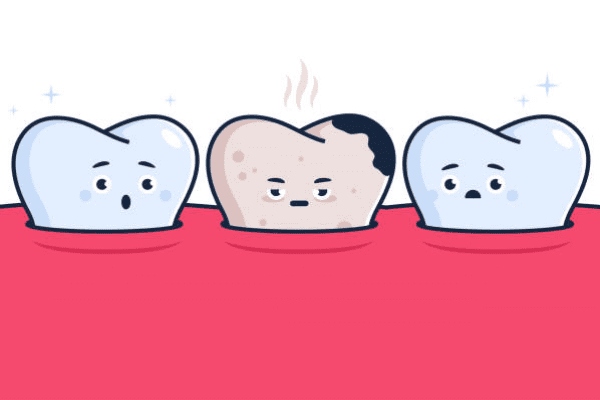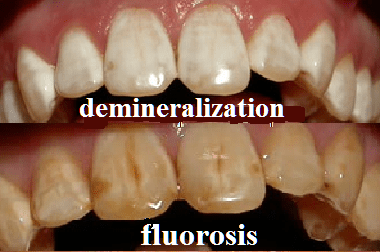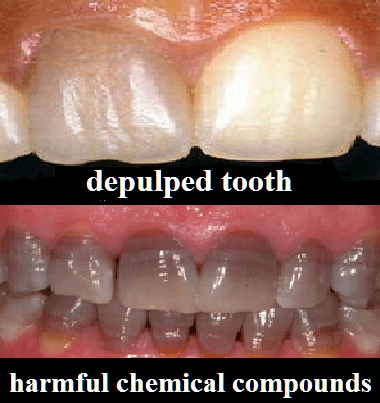Dentistry >>>> Why does teeth discoloration occur?
Why does teeth discoloration occur?

Most people dream of having a white smile. But what if the natural color of the teeth is far from snow-white? What are the chances for a person to affect the shade of his teeth that he has? Why aren't everyone's teeth white?
Ideally, the color of the teeth is determined by the color of the dentin layer, as well as the degree of transparency and the thickness of the enamel covering the dentin of the tooth. It is the color of the dentin of the tooth, and not the color of the enamel of the tooth (as many think) that plays a leading role in the formation of the shade of the teeth visible to us from the side.

The dentin of a healthy tooth is yellow with varying shades. During the life of a tooth, microscopic changes occur in dentin associated with trophic (nutrition) processes of the tooth, especially changes in its mineralization, which in one way or another affect its color and change it in the range from a light yellow shade to varying degrees of brown tones. Many genetically determined conditions and acquired diseases have a direct impact on the condition and color of dentin. The environment also participates in changes in the composition of dental dentin, since we draw all useful and harmful substances from it. Nutritional characteristics, water quality, harmful emissions, drugs change the color of dentin, sometimes not for the better.

Tooth enamel is transparent, but due to its fluorescence, that is, the ability to transform ultraviolet and short-wavelength part of the spectrum of natural light or other light sources, it gives the tooth a more intense color, compensating for the yellowish tint and adding whiteness to the tooth. The thicker the enamel layer, the optically the tooth appears lighter, and vice versa, the thinner the enamel layer, the closer in color the tooth is to the shade of the dentin layer with which it is formed.
The incisal edges are dentin-free and appear more translucent with varying shades of blue, gray and white. At the necks of the teeth (closer to the gingival margin), the enamel layer is thinner, for this reason the necks of the teeth have a color close to that of dentin. In cases where the enamel becomes thinner and the dentin darkens due to certain circumstances, the teeth acquire a yellow or brownish color. This is often observed in certain diseases (pathological abrasion of teeth, physiological abrasion of teeth, imperfect amelogenesis, imperfect dentinogenesis) or as the body ages.
All diseases that change the composition and structure of dentin and enamel change the color of the teeth. Demineralization, fluorosis give the teeth a yellowish-brown color; alkaptonuria will cause a change in one half of the tooth crown (from the neck to the equator) towards blue, and the second half of the tooth (from the equator to the incisal edge) towards a yellowish-brown color; porphyria gives teeth a pink - brown tint, tooth trauma (trauma to the pulp of the tooth) can stain the coronal part of the tooth in various shades of red; enamel hyperplasia, wedge-shaped defect, enamel microcracks disrupt light and color rendering.
Certain chemicals (for example, vapors of acids, metals, alkalis) that enter the body by accident or as part of drugs (for example, tetracycline antibiotics) can give the dentin of the tooth yellow, brown or black. The enamel does not change its color (since it has no color), but its physical characteristics: it ceases to shine and transform light as a result of plaque deposited on it or due to microdestruction.
Filling and restorative materials can lead to a discoloration of the tooth towards grayish, bluish tones. Pulpless teeth turn gray.
In the light of all of the above, it turns out that a lot of factors affect the color of teeth, and very few of them can be changed by a person. If the metabolism is disturbed, then the demineralization of the teeth is inevitable; some diseases inherited or changes in the body acquired in the course of life are almost impossible to influence.
Teeth whitening technologies, as a rule, are aimed at removing plaque from the enamel surface, but they cannot lighten the dentin. In some cases, in order to give the teeth the desired shade, they resort to the imposition of veneers or lumineers on the frontal surface of the teeth included in the smile. This is a good way out when the teeth are not so much bad in color as ugly in shape, have an uneven surface, chips or other defects.
Although in many cases discoloration of the teeth is a little achievable thing, in some cases it is possible to correct the situation. If you notice that your light teeth began to change shade, but there is no plaque on them, then:
- Conduct a blood test for the composition of trace elements and try to replenish the missing mineral compounds in the body by taking mineral complexes.
- Avoid harmful chemical influences from the environment (up to a change of job or place of residence).
- Change your diet towards the consumption of foods that strengthen bone and dental tissue.
- Avoid injuries to your teeth: do not snap seeds and nuts with your teeth, do not open plugs with your teeth, do not gnaw bones, do not hold nails, pencils, pens and other hard objects in your teeth during work, do not bite off strings with your teeth when sewing, do not crunch sweets (lollipops, caramel, roasted nuts or kozinaki). All these "procedures", if they do not break a tooth, will surely ruin the enamel, and broken enamel is a way to change the color of the tooth and its subsequent destruction.
- Examine the body for diseases (especially chronic ones) and provide supportive therapy.
Always remember that dental health is an indicator of overall health.

Read

Read


























